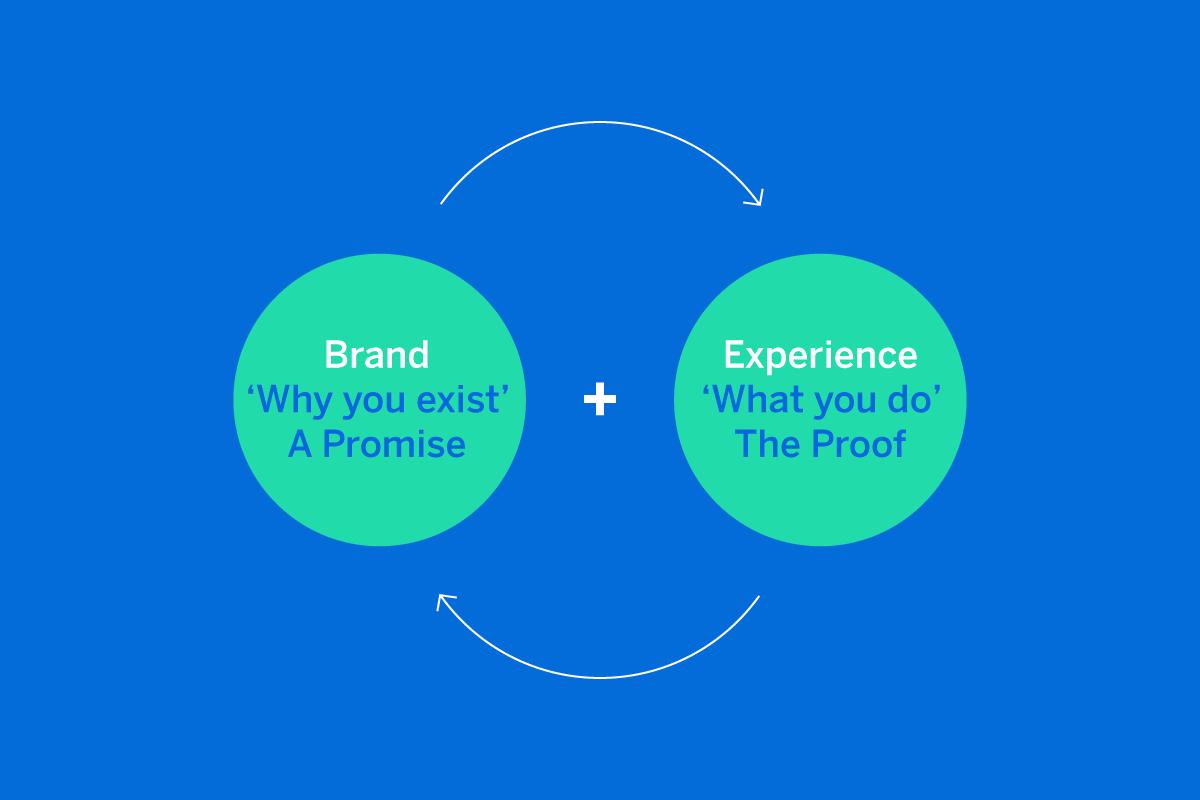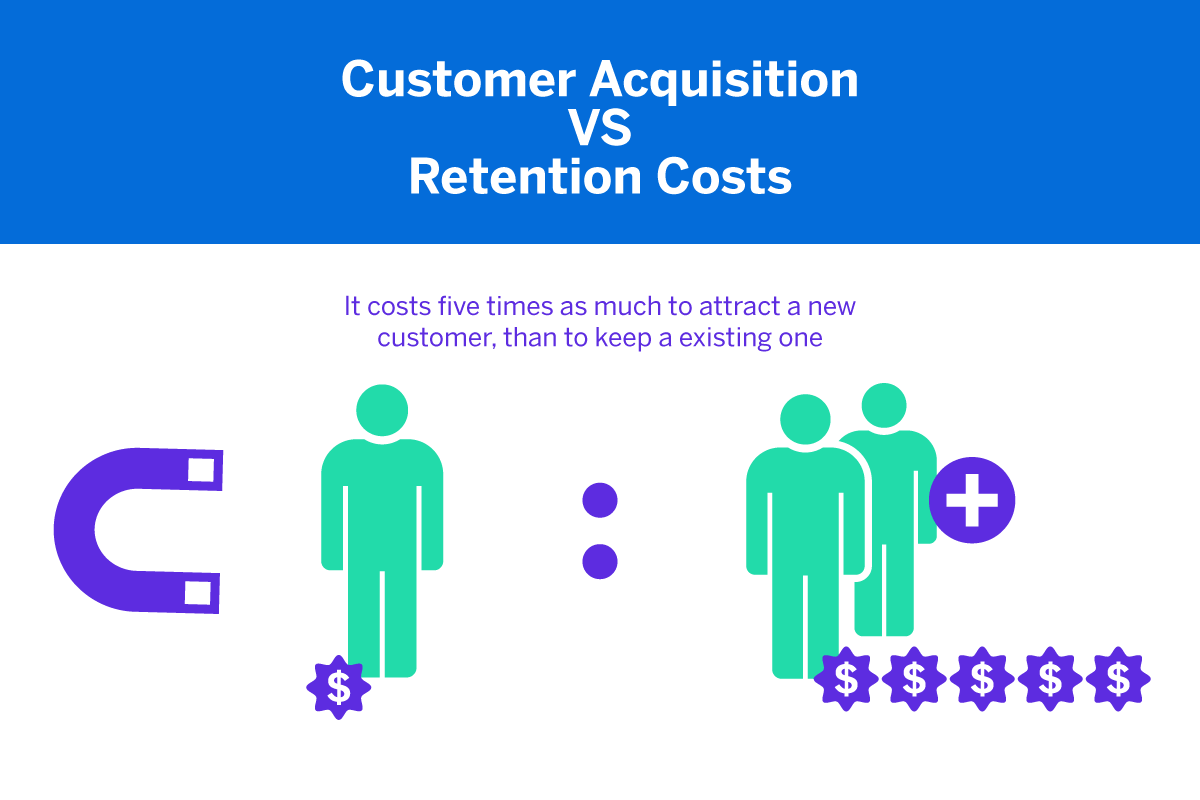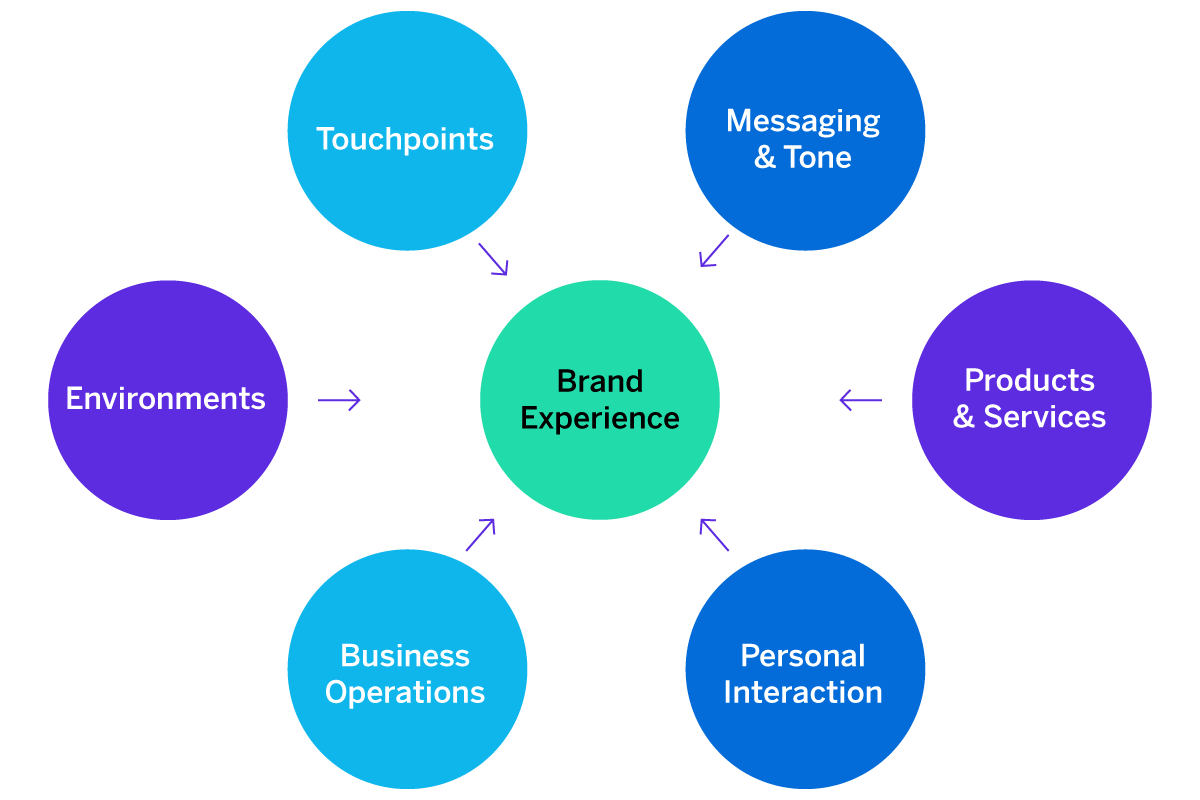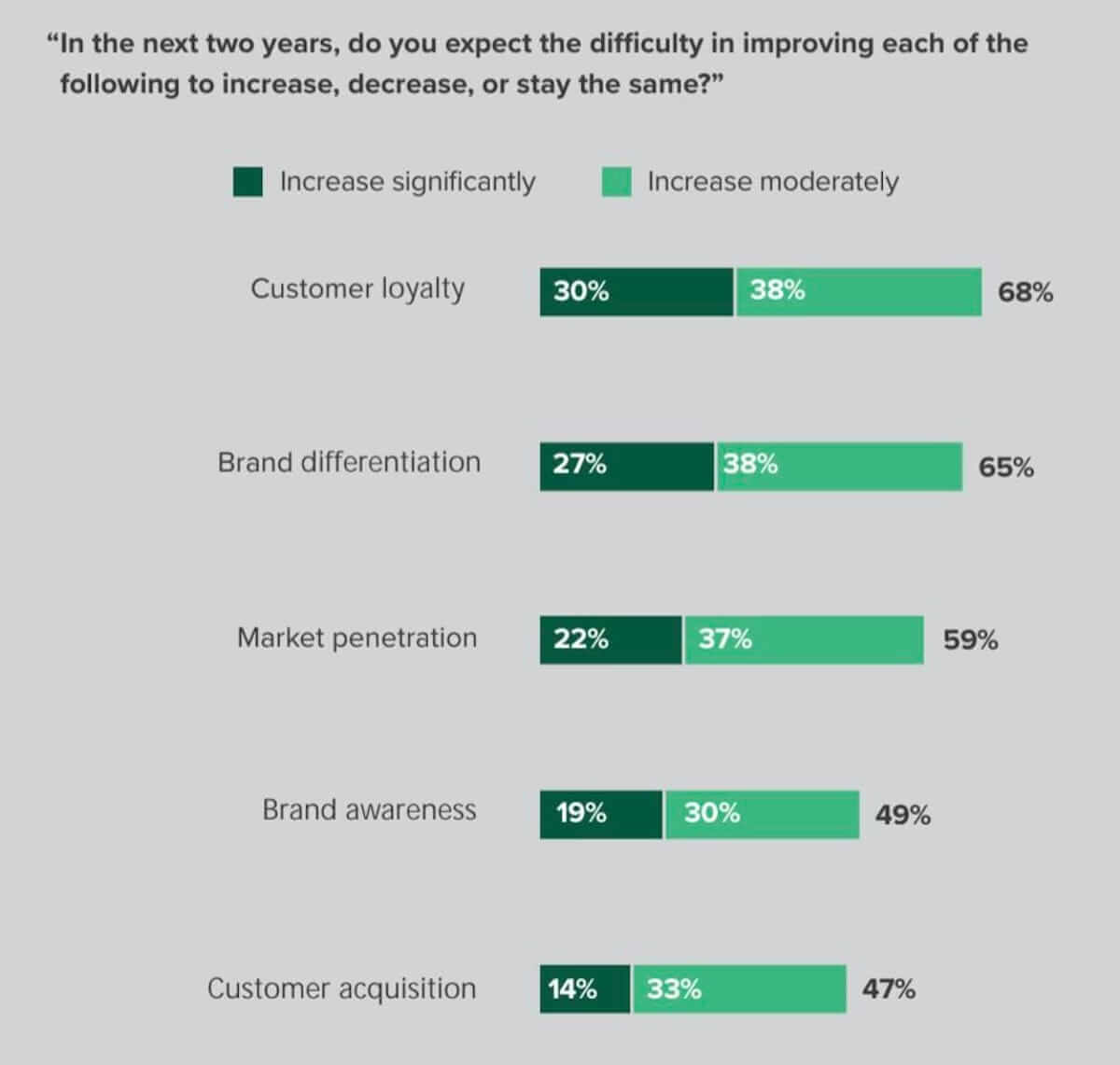What is brand experience?
To understand brand experience fully, it’s useful to remind ourselves of the related customer and employee experiences:
- CX: The feelings, reactions, and ideas that result from direct consumption, purchase, and use of a branded product or service
- EX™: The feelings, reactions, and ideas that result from direct engagement with a business as a current or former employee
With this in mind we can describe brand experience as follows:
BX: The feelings, reactions, and ideas that result from the direct or indirect exposure to any branded/brand-medicated interaction influencing a future purchase decision.
It’s obvious who customer experience and employee experience programs focus on, and these are easily measurable using feedback surveys at touchpoints to collect and analyze actionable data.

A brand is more nebulous. However much a company likes to think it owns a brand and can shape it easily through marketing strategy, brand assets, and social media posts, things are actually a bit trickier than that.
Free eBook: The state of brand experience management
That’s because a brand lives in consumers’ minds, and customer perception can make or break it. And while organizations have never fully controlled their brand, ensuring great brand experience has become even more challenging in today’s hyperconnected world, where every consumer has a megaphone.
A bad reputation, faulty product, rude sales assistant, a company representative saying or doing something controversial – each a bad brand experience – all can harm a brand and prevent future sales.
“[Brand experience is] how consumers interact with brands in real life, generating feelings, beliefs and behaviors that result in comparative marketplace advantages that lead to more sales, pricing power and resistance to competitive threats.”
– Frank Zinni, Senior XM Scientist, PhD
An emotional connection
What if your brand/customer relationship could be such that people are so connected with the brand that they feel they belong to it – that they’re part of the ‘family’, willing to share in the brand’s triumphs and forgive minor transgressions? The word ‘feel’ is important here; brand experience is all about helping your customers form that emotional connection.
Brand experience, really, is the art of creating an ecosystem around the brand in such a way that people can fit themselves into it, and so that when they interact with your brand then they should feel the connection with you.
Why is brand experience important?
Brand experience is important because it engenders brand loyalty. And when you consider that it can cost five times as much to attract a new customer than to retain an existing one, keeping a loyal customer base makes solid business sense.

What does a good brand experience look like?
Because brand experience is all about a holistic, emotional feeling and sense of belonging, a strong brand experience never results from just one interaction.
Companies need to adopt a joined-up approach so that every interaction with a consumer produces those same warm feelings of brand belonging. All these brand experiences are likely to influence how people think, feel, judge, and behave towards the brand.
First up, let’s look at how your marketing strategy can influence brand experience:
1. Direct marketing
- Impeccable customer service that makes consumers want to buy from the brand again (and again)
- Brand-owned website – a rapidly-growing form of direct-to-consumer marketing
- Advertisements that express the brand’s personality and ‘feeling’
- Design – on logos, advertisements, web content, stores, signage, and other marketing communications that chime with customer emotion
- Discounts, rewards, and promotions to attract new customers and reward loyalty
- Newsletters and press releases tailored to interest-specific target audiences
- Product placement or celebrity endorsement in films or commercials
- Influencers on social media
2. Indirect marketing
- Great employee engagement: where enthusiastic employees are also your brand ambassadors, they deliver a great customer experience
- A strong online presence beyond the website into social and search that comes up when customers express a need that the brand can fulfill
- Customer reviews on marketplaces (like Amazon) that describe positive user experiences
- Press articles about the company’s social impact initiatives
In other words? Experiential marketing is the key to building a strong brand.
Every positive interaction and experience with a brand, however large or small, goes towards building brand loyalty over time. By asking consumers about all those moments, and understanding which matter the most and to whom, we can deliver an even better brand experience.
Incorporating the right data
Ok, so the solution here is in gathering feedback, collating user experience data, and making improvements? Well… Yes and no. In today’s omnichannel, always-on business environment, using a traditional brand tracker to gauge customer sentiment towards a brand isn’t enough, because:
- It’s incomplete: Marketers must connect the brand with what’s really going on in the business to ensure it’s driving the organization forward
- It’s not fast enough: With more competition, disruption, and the speed of consumer expectations, businesses need a way to have a constant pulse on their brand and how effective it is in growing new customers
You need to collect data from all the elements of your brand. This is where you bring out your secret weapon – combining O (operational) with X (experience) data:
O-data:
Operational data derived from objective, observable, measurable processes (sales data, finance data, employee data, marketing spend)
X-data:
Experience data that measures attitudes, beliefs, emotions, sentiments, intentions, etc. that often don’t lend themselves to straightforward, objective measurement
The intersection of X and O data unlocks the possibility for more robust predictions, more precise and impactful actions, and long-term positive brand experience management.
Using a combination of customer and brand experience data, and employee experience data, you’ll be better positioned to manage your brand experience at every level: employee, customer, and consumers/public.
And that’s what good brand experience looks like.

Brand experience examples: 3 companies offering a fantastic brand experience
Ok, let’s put what we’ve learned to the test: let’s take a look at brands that act as a great example of honing all those positive experiences, with consumer-centric approaches that ladder up to brand experience:
Duracell
Duracell has taken an everyday item that we put in our remote controls, torches, and children’s toys – a battery – and elevated it to a product whose unstoppable power we feel we can trust. By playing on the concept of power and the emotion of trust, Duracell’s brand experience stands out:
- Through ads telling inspirational, moving stories that create an emotional connection with the brand:
- Through sponsorship of sports, such as NASCAR and rugby
- Through association with the Star Wars movie franchise
Vroom
Vroom Commercial | Dealership Chaos
Vroom is a US online company that really came into its own during the COVID-19 pandemic. The market for second-hand cars boomed with many people unwilling to use public transport, and unable to visit dealerships. Its brand experience was exactly what locked-down car buyers needed:
- High-quality, low-mileage cars with clean vehicle histories
- Easy online finance
- Delivered to your door
- No need to visit pushy, gimmicky dealerships
Apple
APPLE FRENZY: Apple CEO Tim Cook launches iPhone X sales at Palo Alto store
Nobody does total brand experience quite like Apple. Walk down any street and somebody is scrolling on a shiny Apple product – the legacy of Steve Jobs is everywhere. Just how did he, and his Apple team today, achieve such dizzy heights of brand equity?
- They keep it simple: Clean, sleek, consistent design on everything from their computers to their packaging to their marketing emails are instantly recognizable as Apple. They don’t need to clutter their brand identity when the tech speaks for itself.
- They become the product: You hoover your home, wipe your nose on a Kleenex, make a call from your iPhone… Apple ‘owns’ the smartphone market, bringing newer, more innovative features with each new product release.
- They speak their customer’s language: Tech can be utterly bewildering, and Apple knows this. By cutting out the jargon, and communicating in its trademark clean simplicity, Apple presents its features as simple and intuitive to use.
- They are masters of mystery: from feeding rumors of a new product into the media and keeping it top secret until its triumphant unveiling, Apple ramp up the hype to trigger a sales frenzy when a product is released.
- Their CX is premier: In-store, knowledgeable Apple staff make you feel special: they help and advise you, and once that all-important purchase is made, bring you your beautifully boxed product with a certain ceremony from behind the helpdesk.
How to create a strong brand experience
Firstly let’s just remind ourselves of a few key facts:
- Your product or service is what you sell
- Your brand is how your customers perceive you
- Branding is the strategy you use to create that perception
- There is a difference between consumers and customers
- Customers have bought your product before
- Consumers are a brand’s current customers, lapsed customers, and prospective customers
- CX focuses on the existing, current customer
- BX cares about them all.
That’s why your BX strategy has to be well-developed, targeted, and different.. You’re up against:
- More competition than ever before
- More market disruption
- Keeping tabs on consumers who make snap judgments and rapidly change their minds
- Customer empowerment to speak up and choose where to spend their money

A COMMISSIONED STUDY CONDUCTED BY FORRESTER CONSULTING ON BEHALF OF QUALTRICS, 2020
The keys to keeping up with all these challenges are frequency and speed. You need to collect data more frequently and you need to analyze it quickly to inform your strategy. A pulse survey each month is probably the least you should be doing.
A brand strategy that places brand experience at its core recognizes what we noted earlier in this guide: how people feel about you is what they will remember. So always be sure to place your bets in areas that can have targeted, high impact – like digital ads, social media, and influencers.
But you must also be sure that those actions grab attention and evoke an emotional response.
Brand experience strategy
It’s a lot to think about, but don’t worry: if you’re looking to boost your brand experience, drive better brand experiences, and increase customer satisfaction? Here’s how:
- Draw up a mission statement that identifies your target audience, outlines your vision, informs marketing, and puts brand experience at the forefront.
- Tell your company story: everyone loves storytelling – it chimes with us emotionally back to our childhood, and is a great way to make a brand memorable.
- Understand your target audience by performing a segmentation analysis and creating customer personas.
- Build unique brand positioning using your mission, company story, and differentiators to speak to a specific audience.
- Don’t be afraid to get emotional: A brand experience depends upon a relationship with a customer, and sentiment is involved, whether happy, thoughtful, or moving.
- Personalization – this is becoming a major driver for brand experience; when a customer feels valued and treated with empathy – and with a more bespoke user experience – they’re more likely to remain brand loyal.
- Find the ways that your customers will respond authentically whether on social channels, with reviews, etc. Customers can greatly influence the perception of the brand to new audiences.
- Enhance your in-person experience: whether it’s pop-up events, in-store offerings, or collaborations, use live experiences and employees to immerse consumers and create memories.
How do you increase customer loyalty with BX?
It’s been argued that brands grow by being mentally and physically available, and there is beauty in this simplicity. If we pick that logic apart, it follows that nailing the brand experience – by having an ethos of empathy and availability – can positively influence a bunch of associated brand metrics.
After all, it’s those positive customer feelings that go on to define things like brand image, overall brand awareness, and – importantly – customer loyalty.
The ultimate guide to measuring and boosting yours
Experiences happen at an emotional level: it’s the feeling that the experience evokes that triggers the memory of the brand, driving overall brand awareness. Research shows, meanwhile, that brand experience has a positive influence on brand image. And, ultimately, a strong brand image influences consumers to choose a company’s products or services – because how your consumers perceive you may pre-determine whether they will use your brand.
If you’re interested in boosting customer loyalty by building a better brand experience, here are a few practical tips:
1.Keep a finger on brand pulse
If you’re only checking in on your brand experience semi-regularly, you’ll be working with already out-of-date data. The best way to continually measure sentiment, brand loyalty, consumer intent, and ease of doing business is by using real-time data, powered by AI conversation analytics.
Today’s brand management software can automatically surface and prioritize emerging trends, risks, and user experience opportunities expressed by consumers, no matter which channel they’re on – from social media accounts to customer service conversations.
Qualtrics’ XM Discover platform is a great always-on solution for this. It can scour every channel, and every interaction, to flag actionable insights. If you’re listening to the conversations people have about your brand with an omnichannel ear, you get a more complete picture of what’s really going on – and create a culture of action around those insights.

2.Keep an eye on the competition
How customers perceive your brand experience will automatically improve if you’re offering things your competitors can’t. It pays, then, to understand the strengths and weaknesses of your competitors’ brands, to spot gaps in the market, and to identify points of differentiation.
Using an experience management tool like XM Discover will enable you to understand what people are saying about your competitors – and how that compares.
3. Get on your customers’ good side
Customers will naturally feel more loyal to companies whose values align with theirs, so your communications and marketing efforts must be fine-tined and appropriately engaging.
Experience and brand management suites like the XM Platform™ can offer real-time reactions, and reveal how your advertising and marketing campaigns are landing – and who they’re landing with. With that information, you can make decisions that drive stronger marketing campaigns that land with existing customers and new customers alike.
Free eBook: The state of brand experience management